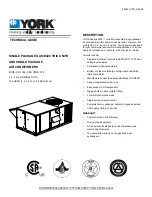
Troubleshooting support
Ĉ
·
The failure mode detected on the indoor unit side is displayed by
blinking the "timer lamp". And a failure detected on the outdoor
·
If the outdoor unit side detects a failure, the product will first
conduct several operation retrials.
There are some failure modes with no lamp display while retrials
are continued.
ailure mode where retrials are continued and the indoor unit lamp
does not end up giving a display
ǂ
OH thermistor heat-up
ǂ
Overload lower limit cut
ǂ
Low-frequency things
·
The failure modes detected on the indoor and outdoor unit sides
are stored in the nonvolatile memory of the indoor unit and can be
read later on.
ǂ
The memory will remain even after power-off.
·
The failure modes detected on the outdoor unit side are written in
memory every time any such mode occurs. The failure mode can
therefore be detected on the indoor unit side without waiting for
the retry frequency to reach the display of the indoor unit lamp.
Moreover, the normal self-diagnosis display function which rarely
occurs will store and display failure modes that do not end up
displaying the indoor unit lamp.
ǂ
Any such mode may be unable to be stored if indoor or outdoor
communications is in a failure.
·
The product stores 5 last-stored failure modes.
·
There is a function for deleting memory. Once you clear the
memory and run the product for several days, you can read the
failure modes and check them, thereby detecting the less
frequent failure phenomena.
·
ailure modes can be checked by both the blinking of the lamp of
the indoor unit and the display of the remote control liquid crystal
display.
·
The failure mode detected on the outdoor unit side is displayed by
ǂ
blinking the "LD301". Detecting a failure will stop the outdoor unit
ǂ
and keep blinking the LD301 until it is restarted.
ǂ
The communication error will persist until the communication is
ǂ
reestablished.
Ć
The "self-diagnosis function of the communication circuit" available in our conventional models is now incorporated
as part of the normal self-diagnosis function. In the case of a failure in the communication circuit, you do not have
to conduct a special operation and the operations can be automatically divided into 3 blinking operations and 12
blinking operations of the timer lamp. However, a strong external noise may have resulted in 12 times of blinking.
unction
n
o
it
p
ir
c
s
e
D
Self-diagnosis display
Display on the indoor
unit side
Display on the
outdoor unit side
Self-diagnosis memory
unit side will be indicated by the "time lamp" blinking 4 times.
68
Summary of Contents for RAC-18WPD
Page 2: ... DANGER 2 ...
Page 24: ...24 ...
Page 25: ...25 ...
Page 26: ...26 ...
Page 28: ...Contact your sales agent immediately if the following phenomena should occur Notes 28 ...
Page 31: ...WIRING DIAGRAM RAK 15QPD RAK 18RPD RAK 25RPD RAK 35RPD RAK 42RPD RAK 50RPD 31 ...
Page 33: ...CIRCUIT DIAGRAM MODEL RAK 15QPD 33 ...
Page 34: ...CIRCUIT DIAGRAM MODEL RAK 18 25 35 42 50RPD 34 ...
Page 57: ...10 10 10 10 10 DSW1 57 ...
Page 61: ...RL1 RL1 RL2 61 ...
Page 70: ...68 70 ...
Page 73: ...37 and page 38 73 ...
Page 75: ...57 75 ...
Page 76: ...76 ...
Page 77: ... 䇭䇭 䇭䇭 䇭䇭 䇭䇭 䇭䇭 䇭䇭 B C E F 㺢 F 䌖 B GH E H C J E 77 ...
Page 78: ... 䇭䇭 G FK 㺢 F L M C B C M C E C B H C E B M C E C B M C 78 ...
Page 93: ...RAK 15QPD RAK 18RP RAK 25RP D D RAK 35RP RAK 42RP D D RAK RPD 50 JCH WH NO 0108E 93 ...
















































